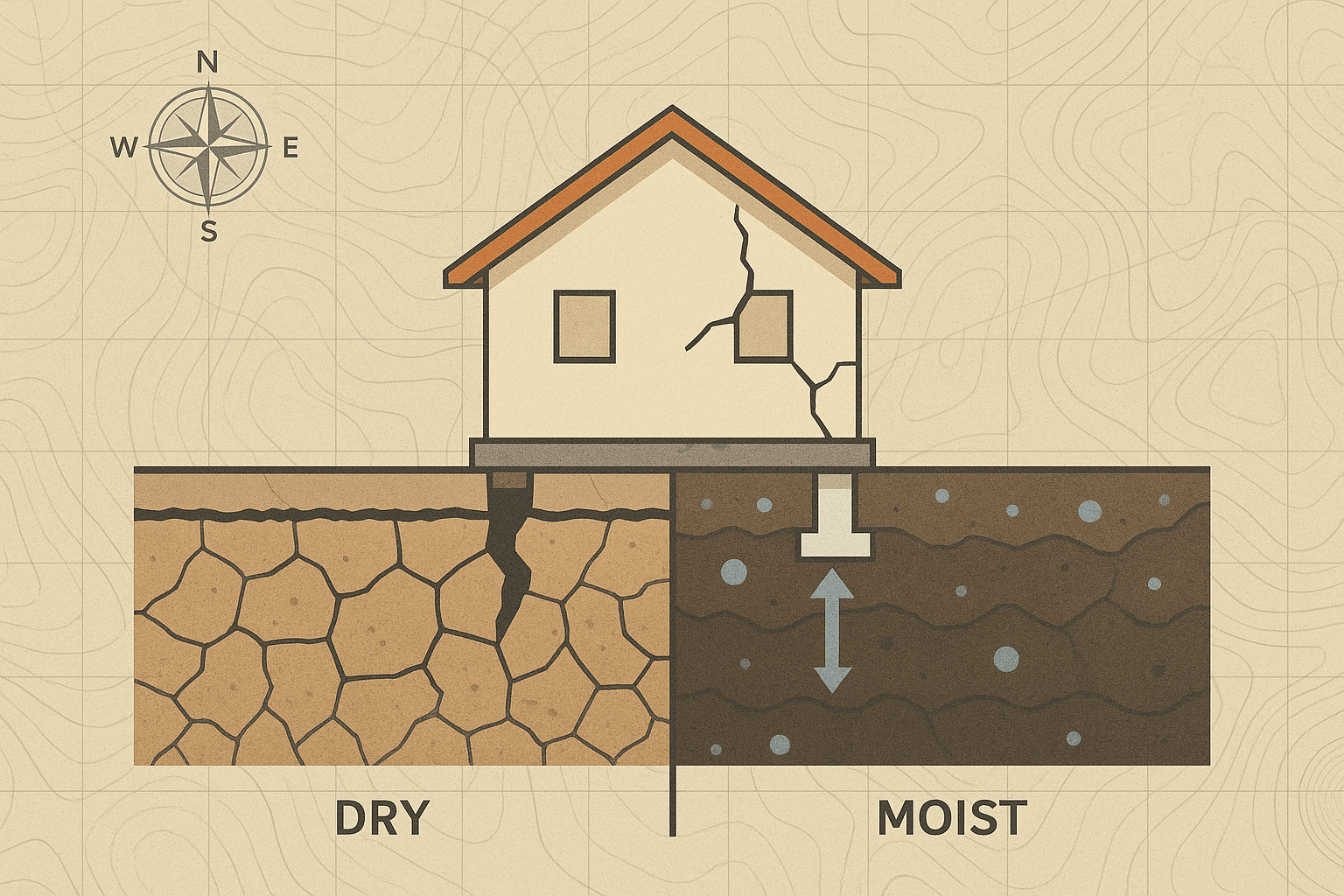What is Expansive Soil?
At its core, expansive soil is a type of clay-rich soil that acts like a terrestrial sponge. When it absorbs water, it can swell dramatically, increasing in volume by 10% or more. During dry periods, it loses that water and shrinks, often leaving behind a network of deep, wide cracks. This cyclical swelling and shrinking exerts immense and often uneven pressure on anything built upon it.
The secret ingredient behind this behavior is a group of clay minerals known as smectites, with montmorillonite being the most common culprit. At a microscopic level, these minerals are composed of incredibly thin, stacked plates. Water molecules are electrochemically attracted into the tiny spaces between these plates, prying them apart and causing the entire soil mass to heave upwards. When the weather turns dry and the soil desiccates, the water molecules leave, and the plates collapse back onto each other, causing the ground to subside.
A Hidden Hazard with a Global Footprint
This isn’t a localized quirk of geology; it’s a global phenomenon. Expansive soils are found on every continent (except Antarctica) and are particularly common in arid and semi-arid regions with distinct wet and dry seasons. These climates provide the perfect cycle of wetting and drying that drives the destructive process. The parent rock is also key, with shale, marl, and volcanic rock often weathering to produce the necessary smectite clays.
Mapping this hazard reveals a vast geographical distribution impacting hundreds of millions of people:
- The United States: Expansive soils are a major issue stretching from the Gulf Coast of Texas and Louisiana, up through the Great Plains of Oklahoma, Kansas, and Colorado, and into parts of the Dakotas and California. Cities like Dallas, Houston, and Denver are built on notoriously volatile ground, making foundation problems a common homeowner headache.
- Australia: Known locally as “cracking clays”, these soils cover vast swathes of the eastern states, particularly in Queensland and New South Wales, underpinning much of the nation’s agricultural heartland and impacting rural towns.
- India: The Deccan Plateau is covered by enormous deposits of expansive soil called “black cotton soil” or Regur. These soils are fertile but pose significant engineering challenges for the region’s rapidly growing infrastructure.
- Canada: The Prairie provinces of Saskatchewan and Manitoba contend with the legacy of ancient glacial lakes, which left behind thick deposits of expansive clay. The city of Regina is particularly famous for its challenging soil conditions.
- Other Hotspots: Significant areas of expansive soil are also found across Sudan, Ethiopia, South Africa, Israel, Spain, and China, each presenting unique challenges for agriculture, construction, and urban planning.
The Slow-Motion Disaster: Billions in Damage
While a hurricane or a flood causes damage over hours or days, expansive soils work their destruction over seasons and years. This slow, cyclical movement makes it the most costly natural hazard most people have never heard of. In the United States alone, the American Society of Civil Engineers estimates that expansive soils cause billions of dollars in damage each year—more than earthquakes, floods, and tornadoes combined.
The damage manifests in numerous ways:
- Residential and Commercial Buildings: The first signs are often subtle—doors that stick, windows that won’t close properly, and small cracks in drywall. Over time, these escalate to large, diagonal foundation cracks, heaving floors, and broken brickwork, potentially rendering a building structurally unsound.
- Roads and Highways: Pavement built on expansive soil often develops a characteristic “roller-coaster” undulation as different sections of the ground swell and shrink at different rates. This leads to cracked asphalt, potholes, and a costly, unending cycle of repairs.
- Underground Infrastructure: The forces are powerful enough to bend and break buried pipelines. Water mains, sewer lines, and gas pipes are all vulnerable, leading to leaks that can not only disrupt services but also worsen the problem by saturating the soil and causing even more swelling.
Living on Breathing Ground: Adaptation and Engineering
Since we can’t stop the ground from moving, human geography has adapted through clever engineering and site management. In areas known for expansive soils, constructing a building is about more than just laying a simple concrete slab.
Engineers have developed several strategies to mitigate the risk:
- Isolate the Foundation: Techniques like pier-and-beam or drilled pier foundations anchor the structure to stable soil or bedrock deep below the active zone of swelling and shrinking. This allows the ground to move without transferring the stress to the building itself.
- Strengthen the Foundation: Post-tensioned slab foundations, which are reinforced with a grid of high-strength steel cables, are designed to be rigid enough to “float” on top of the moving soil like a raft, resisting the bending forces.
- Control the Moisture: The most crucial element is managing water. This involves sophisticated drainage systems to channel water away from the foundation, avoiding planting thirsty trees and shrubs too close to a building, and sometimes even using underground barrier systems to maintain a consistent moisture level in the soil.
Ultimately, the key is to recognize and respect the dynamic nature of the ground. Geological surveys, soil testing, and updated building codes are the first line of defense, ensuring that we build not just on the land, but with it. As our cities continue to expand into challenging geological terrain, understanding this slow-motion hazard is more critical than ever. The ground beneath our feet is alive, and learning to accommodate its rhythm is the only way to build a resilient future.
